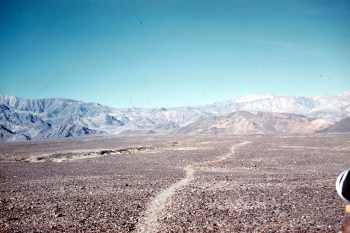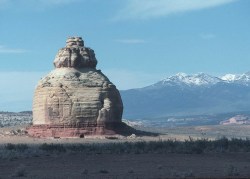Features of wind erosionLandscapes formed from the work of wind result from either the removal of fine particles, or the sculpting effects of material in movement. Deflation lifts and removes loose particles from the surface. Deserts where soils of mixed particle size have been eroded of fines leave a cobblestone-like surface behind called desert lag or desert pavement.The interlocking pavement of stones protects the underlying surface from the wind. If disturbed, the surface becomes subject to erosion. Such has been the result of surface degradation from military activities in the desert regions of North Africa during World War II (as well as later conflicts fought in the desert regions of the Middle East).
Figure 20.3 Old Native American road cut through pavement, Death Valley, California. Courtesy USGS Deflation may also result in blowout depressions, basins ranging in size from less than a meter to many meters deep. Chemical weathering of cementing materials loosens particles cohesiveness to enable wind erosion. Some extremely large depressions like the Qattara Depression in the western desert of Egypt are partially a result of deflation.
Sand particles lifted free of the surface can "sand blast" rock surfaces in a process called abrasion. Abrasion shapes and polishes exposed bedrock. Abrasion is restricted to a distance of about a meter or two above the surface because sand grains are lifted a short distance. Ventifacts are smooth faceted rocks that often have a polished surface that results from abrasion. At a much larger scale, elongate ridges called yardangs form by the abrasion and streamlining rock structures oriented parallel to the prevailing wind direction. Abrasion occurs at the windward end while deflation removes material from the leeward end. Archaeologists have suggested that the Great Sphinx of Giza, Egypt is partially formed from a yardang. |


